#claire ridgeway
Text
The kyng, after his returne [from Calais] maried priuily[privily] the lady Anne Bulleyn on sainet Erkenwaldes daie [14 November], whiche mariage was kept so secrete, that very fewe knewe it, til she was greate with child, at Easter after.
—Edward Hall’s account of Henry VIII and Anne Boleyn’s secret wedding on 14 November 1532 [via On This Day in Tudor History by Claire Ridgeway]
14 notes
·
View notes
Text
For I am already married to this Common Weal and the faithful members of the same; the spousal ring whereof I have on my finger: which never hitherto was, nor hereafter shall be, left off. Protesting unto you nothing to more acceptable to my heart, nor more answerable to my will, then your advancement in wealth and welfare, with the furtherance of GOD’S glory.
—Mary I denouncing Wyatt’s rebellion on 1 February 1554 [via On This Day in Tudor History by Claire Ridgeway]
11 notes
·
View notes
Text
The French king said that the king of England had fallen from his horse, and been for two hours without speaking. “La Ana” [Anne Boleyn] was so upset that she miscarried of a son.
—Dr. Ortiz’ report of Henry VIII’s 1536 jousting accident [via On This Day in Tudor History by Claire Ridgeway]
8 notes
·
View notes
Text

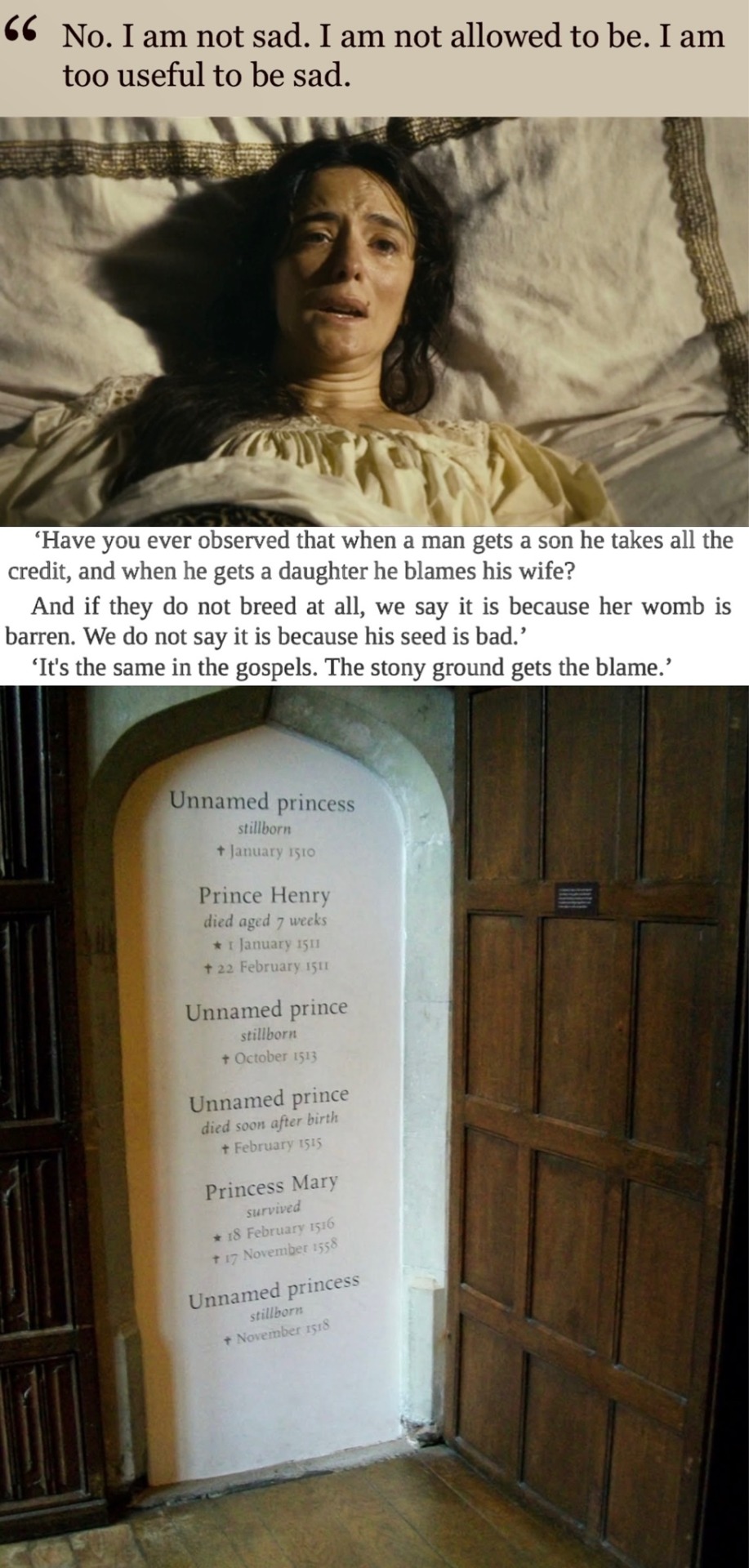
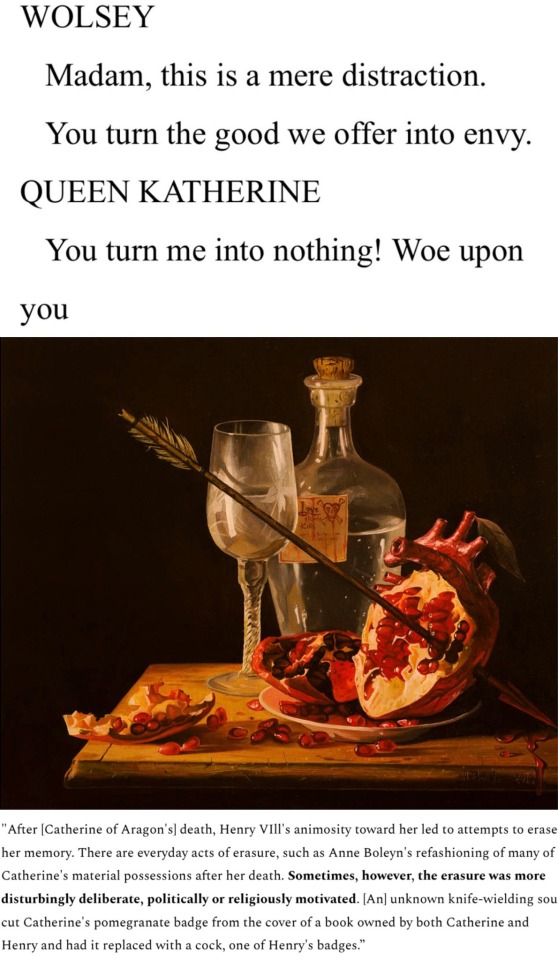



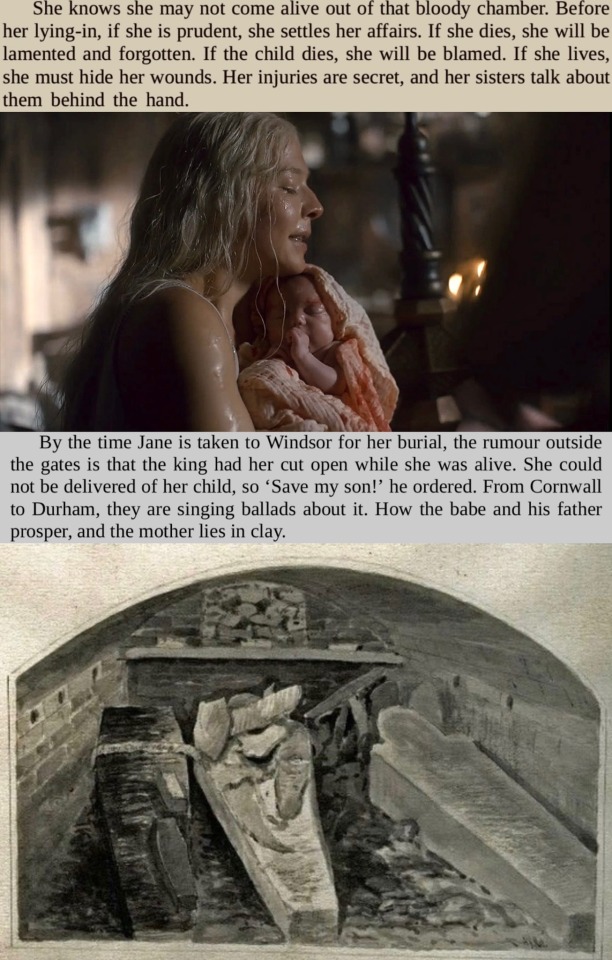

YOU TURN ME INTO NOTHING, WOE UPON YOU
The Mirror and the Light, Hilary Mantel / Ana Torrent in The Other Boleyn Girl / Wolf Hall, Hilary Mantel / memorial for Catherine of Aragon’s children at Hampton Court / Henry VIII, William Shakespeare / Love Slowly Kills, borda / Catherine of Aragon: Infanta of Spain, Queen of England, Theresa Earenfight / Houses of Power, Simon Thursley / Portraith with a serpent, X-Ray , unknown painter / Henry VIlI and Anne Boleyn's initials, King's College Chapel, Cambridge / Catherine of Aragon: Infanta of Spain, Queen of England, Theresa Earenfight / 29 January 1536 – Anne Boleyn “Miscarried of her Saviour”, Claire Ridgeway / Natalie Dormer in The Tudors / The Mirror and the Light, Hilary Mantel / Postcard, Amazon Quarterly / Roman Marble Relief of the Three Graces, circa 2nd Century A.D. / Catherine of Aragon: Infanta of Spain, Queen of England, Theresa Earenfight / Poster for Mother!, James Jean / The Mirror and the Light, Hilary Mantel / Unfinished portrait of Jane Seymour, after Hans Holbein the younger / This Is Not The Portrait Of Jane Seymour, Edoardo de Falchi / The Mirror and the Light, Hilary Mantel / Emma D’Arcy, House of the Dragon / The Mirror and the Light, Hilary Mantel / Henry VIII’s vault, A.Y. Nutt / The Mirror and the Light, Hilary Mantel / Saiorse Ronan in Mary, Queen of Scots / 1782 depiction of Katherine Parr’s lead coffin, unknown / The Mirror and the Light, Hilary Mantel / a piece of hair cut from the head of Katherine Parr, collection of Sudeley Castle / a piece of Katherine Parr’s burial gown, collection of Sudeley Castle / The Mirror and the Light, Hilary Mantel
#historicwomendaily#katherine of aragon#katherine parr#jane seymour#anne boleyn#catherine of aragon#henry viii#wolf hall#miscarriage tw#blood tw
747 notes
·
View notes
Text
Anne Boleyn and Ireland?

Every year around this time, I start to see the “Anne Boleyn had Irish ancestry” myth going around and I just kind of want to set the record straight. Anne Boleyn had very little (to no) ethnically Irish ancestry. The Butlers (the supposed Irish ancestors) were descents of the Walters who were put into power in Ireland after the Anglo-Norman Invasion of 1169. The Earldom of Ormond (which Anne’s father had tried to make claim too, which resulted in the possible AB/James Butler match) was a part of Ireland known as “The Pale”.

The Pale was an area in Ireland that was under direct control of the English. English laws, language and customs were enforced here, causing many of the native Gaelic people to be pushed out. Those in charge of The Pale were of Anglo-Norman descent, such as the Butlers. The only Gaelic lords who were able to keep power during the Tudor period were those that swore allegiance to the crown. Now to get into the nitty gritty details of Anne’s ancestors. Anne’s father, Thomas Boleyn was the grandson of Thomas Butler, the 7th Earl of Ormond. When looking through the genealogy there’s only two cases of intermarriage between the Anglo-Norman Butlers and the Irish nobility (who were also not ethnically Irish) So Anne’s grandmother, Margaret Butler Boleyn would have been considered an Irish noblewoman, but it’s a bit more complicated than that.

Kilkenny Castle, where Margaret Boleyn was born
She was of Norman ancestry rather than of Irish ancestry. Tracing Margaret’s lineage, I found almost no Gaels/Celts in her line, which can be traced back to Edward I. Therefore Anne Boleyn had very no Irish in her blood. That is not to say she did not feel connected to Ireland due to her ancestors having a seat there, but she is not comparable to the Irish Americans of today, most of whom are descendants of Irish Catholics fleeing the Famine and then the violence after The Partition (my family being the later). Ireland under the Tudors was not good. The Tudors terrorized the Irish. There was so much bloodshed due to suppression of Irish culture, colonization and the enforcement of Protestantism. Anne Boleyn didn’t really have anything to do with that (although it was illegal to insult the marriage of Henry VIII and Anne Boleyn in Ireland from 1533 to literally a couple years ago.) but I feel like it needs to be talked about. Idk if this makes any sense, but it just feels like such an oversimplification of some really dark history when people are like “Anne Boleyn was Irish!!!! Happy St. Patrick’s Day!!!!!!!☘️☘️☘️☘️) Claire Ridgeway said it best on The Anne Boleyn Files, ““Anne Boleyn was Irish?!”, I hear you cry! Well, no, but she was descended from a noble family’s whose family seat was in Ireland through her paternal grandmother” Anyways Happy St. Patrick’s Day! Anne Boleyn really wasn’t all that Irish after all!

Note: I’ve really simplified Irish history and the history of English control in Ireland. I know this, you don’t have to tell me. This post is about Anne Boleyn and the persisting claim that she was Irish, not the complicated and sad history of English colonialism.
32 notes
·
View notes
Text
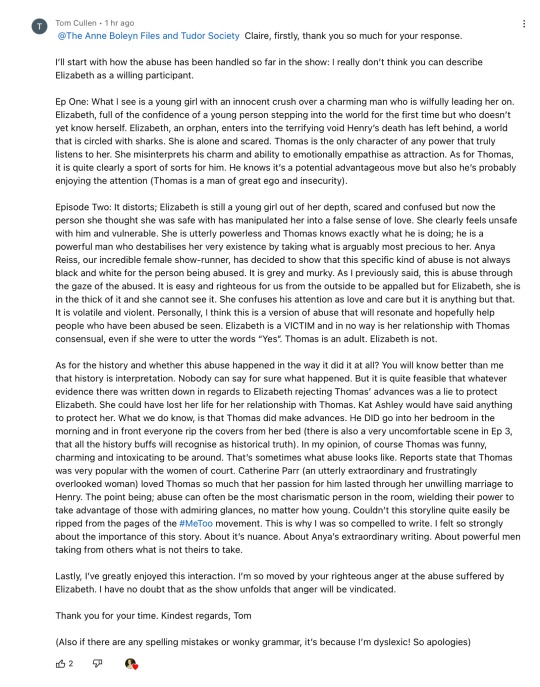
Tom Cullen’s second comment to Claire Ridgeway.
163 notes
·
View notes
Text
tom cullen’s comment on claire ridgeway’s video!!

106 notes
·
View notes
Text


Full Name: Carly Lisa Shay
Nicknames: My Sister (by Spencer), Carls, Cupcake, Carly Girl, Mrs.Benson (by Sam), My Best Friend (by Sam and Freddie), My Girl, Frisky, Life Alert (by Freddie), Little Baby, Kiddo, My Sweet Carly, Girl, (by Spencer), Stupid American Girl (by Wade Collins), Dumbo, Dummy (by Mrs. Benson), Aunty Carly (by Charlie and Julie)
Gender: Female
Birthday: July 24, 1994
Age: 29
Occupation: Host of iCarly/YouTuber, Student at Ridgeway Junior High School (formerly, graduated), Employee at The Groovy Smoothie (formerly), Employee at the 32 Flavors Ice Cream Shop (formerly)
Education: Ridgeway Junior High School (graduated)
Residence: Apartment 8-E, Bushwell Plaza (currently), Apartment 8-C, Bushwell Plaza (formerly), Italy (formerly)
Hair Color: Dark brown, Brown with blonde highlights (revival season 1 & 2), Dark Brown (revival season 3)
Eye Color: Brown
Family: Colonel Steven Shay (father), Mrs. Shay (mother), Spencer Shay (older brother), Granddad Shay (grandfather), Gramma Shay (grandmother), Great Grammy Shay (great-grandmother), Barry Dorfman (uncle), Tess Dorfman (aunt), Faye Dorfman (cousin), Ozlottis Dorfman (cousin), Margaret (aunt), Sunny Johnson (11th cousin), Potter Shay (niece), Julia Puckett (honorary niece), Charlie Shay (niece), nine other nieces and nephews
Friends: Harper Bettencourt (best friend; roommate). Freddie Benson (best friend), Tori Vega (close friend, future girlfriend), Millicent Mitchell, Sam Puckett (best friend), Principal Franklin, Sunny Johnson (11th cousin), Gibby Gibson, T-Bo, Melanie Puckett, Wendy, Shelby Marx, Missy Robinson (formerly), Claire, Toji, Gwen, Paul Denham, Lewbert Sline, Tinsley
Romances: Tori Vega (crush, has feelings for), Sam Puckett (kissed one, bi awakening), Freddie Benson (Ex Boyfriend), Ben Huebscher (first kiss), Jake (former crush), Gibby Gibson (one date), Shane (dated), Nevel Papperman (alternative reality boyfriend), Griffin (ex-boyfriend), Austin (one date), Adam (former crush), Steven Carson (ex-boyfriend), Kyle (ex-boyfriend), Cort (former crush), Lance (one date), Gary Wolf (former crush), Luke Tyler (one date), Justin (dated), Trenton (one date), Beau (ex-boyfriend), Wes (ex-boyfriend), Troy (dated)
Pets: Cookie (former bunny), Shelly (former baby chick), Huevo (former baby chick), Omelet (former baby chick), Benedict (former baby chick), Yoko (former baby chick), Poachy (former baby chick), Sparky (former dog)
Enemies: Nevel Papperman, Tasha, Valerie, Ms. Briggs, Mr. Devlin, Jonah, Amber Tate, Zeebo, Ms. Ackerman, Kyoko and Yuki, Wade Collins, Missy Robinson, Chuck Chambers, Chip Chambers, Mr. Howard, The Petographers, Nora Dershlit, Mr. and Mrs. Dershlit, Penny Tee Employees, Steven Carson, Aspartamay, Ashley, Dana Bukowski, Mandy Valdez, Griffin, Beau, Wes, Argentina Woolridge, Pearl Wallace, Prunella Pitz-Papperman, Emily Haines, Myrtle, Her mother
First Appearance: iPilot (OG), iStart Over (Revival)
Last Appearance: iGoodbye (OG), TBD
4 notes
·
View notes
Text
Announcing the relocation of our Junior girls onto the Junior boys site to create Claires Court Juniors at Ridgeway
Our fundamental aim for Claires Court has always been to ensure parity of education, opportunity and equality through the breadth of the curriculum and our teaching practice. To oversee this in the primary phase, last year we promoted Mrs Kirby to the new position of Head of Juniors (Boys, Girls and Nursery). Since then, together with her leadership team, she has successfully developed the junior…
View On WordPress
0 notes
Quote
This room is where a very young Anne and Mary have learnt numerous stitches from their governess, Mrs Orchard, their mother, Lady Elizabeth Howard, and their grandmother, Lady Margaret Butler. Here, the women of the household talk – or parlay (hence ‘parlour’) – and complete the blackwork for their smocks and shirts for the men of the household. This isn’t considered labour for women of the Boleyns’ status, for all its effort.
Ridgway, Claire; Emmerson, Owen. The Boleyns of Hever Castle (p. 23).
63 notes
·
View notes
Text

From George Boleyn: Tudor Poet, Courtier, & Diplomat by Claire Ridgeway
3 notes
·
View notes
Text
On this day in history, 20th February 1547, King Edward VI was crowned King at Westminster Abbey. However, the celebrations had begun the day before…
On the afternoon of Saturday 19th February, the boy King processed out of the Tower of London. He was dressed in white velvet, which was embroidered with silver thread and decorated with lovers’ knots made from pearls, along with diamonds and rubies. He also had a gown of gold mesh and a sable cape, and the horse upon which he rode had been dressed in crimson satin decorated with pearls.
The procession consisted of the King’s messengers, the King’s gentlemen, his trumpeters, his chaplains and esquires of the body, all walking. Then came the nobility on horseback and members of the council paired with foreign diplomats. After them processed the gentlemen ushers and Henry Grey, the Marquis of Dorset and Constable of England, bearing the sword of state. Finally, there was the nine year-old king, Edward VI, escorted by the Duke of Somerset (his uncle, Edward Seymour) and the Earl of Warwick (John Dudley). They were followed by the Sir Anthony Browne (the King’s Master of the Horse), the henchmen, the Gentlemen of the Privy Chamber, the pensioners and the guard.
Edward VI’s biographer, Chris Skidmore, writes of how Cheapside was richly decorated with cloth of silver and gold, but that some of the pageants arranged for the day, at very short notice, “turned into shambles”. One pageant drew on the coronation of Henry VI as King of France in 1432, another boy king, and another made use of Jane Seymour’s phoenix, Henry VIII’s lion and the roses and hawthorn bush devices of the Tudor dynasty. Skidmore describes how the phoenix descended from the heavens to land on a mount decorated by red and white roses and hawthorn bushes. A crowned lion then approached, followed by a young cub. At the cub’s appearance, two angels descended and crowned him with an Imperial crown. The phoenix and lion then departed, leaving the crowned cub alone
Other displays along the route included depictions of Edward the Confessor, St George and “Truth”, a child representing the New Religion. Skidmore writes of how the young king particularly enjoyed watching a tightrope walker, who balanced along a cable as he descended to kiss the King’s foot.
The next day, at 9am, King Edward VI travelled to Whitehall by barge. He was met by the guard and pensioners and then he walked to the chamber of the Court of Augmentations, where he put on his Parliament robes of ermine-trimmed crimson velvet. The King then processed to Westminster Abbey for the coronation ceremony under a canopy carried by the barons of the Cinque Ports. He was flanked by the Earl of Shrewsbury and the Bishop of Durham, and followed by John Dudley, William Parr and Thomas Seymour, who all bore his train. Behind them processed the Gentlemen of the Privy Chamber, the nobility, the pensioners, the guard and the court servants.
A dais had been erected in the richly decorated Abbey. On it was a throne decorated in damask and gold, with two cushions to help raise the small King. The traditional coronation ceremony, used since 1375, had been adapted for the boy King. Instead of twelve hours, it would be seven. Thomas Cranmer, Archbishop of Canterbury, had also changed the coronation oath so that “reformation of the Church could now be enabled by royal prerogative, the king as lawmaker”. The changes were explained in a sermon by Cranmer, who also likened Edward to the Biblical Josiah, and then the young king was anointed and crowned with the St Edward’s crown, the Imperial crown and a custom-made lighter crown. Edward then held the orb, the sceptre, St Edward’s staff and the spurs. He was King, and the nobility now came before him one by one to kiss his left cheek.
The coronation ceremony was followed by a banquet in Westminster’s Great Hall, more feasting and entertainment at Whitehall, and then two days of jousting and feasting.
Trivia: Edward VI was the first monarch to be anointed as Supreme Head of the English Church.
—Claire Ridgeway, On This Day in Tudor History
1 note
·
View note
Text
On 12th January 1510, Henry VIII jousted for the first time as King. The joust was a private one, and took place at Richmond Park. Henry and his friend William Compton attended in disguise, and there was panic when Compton was seriously injured by Edward Neville. Nobody knew whether it was Compton or the King, and it was only when his visor was raised that people knew, and someone cried out “God save the King!”. Then the King took off his disguise to reassure worried spectators.
—Claire Ridgeway, On This Day in Tudor History
4 notes
·
View notes
Text
youtube
History of Halloween and Hallowtide
1 note
·
View note
Text
Easter in Tudor Times
|- “ On Maundy Thursday, the church was prepared for Easter with water and wine being used to wash the altars. It was also traditional for people to go to confession on this day.
On Good Friday in Tudor times, people would attend the ceremony known as “Creeping to the Cross”. Christ’s suffering and crucifixion, and what it meant to people, were commemorated by the clergy creeping up to a crucifix held up before the altar on their hands and knees. When they got to the crucifix, they would kiss the feet of Christ. The crucifix was then taken down into the church for the congregation to do the same.
Good Friday was also the day for the preparation of the Easter Sepulchre. The sepulchre consisted of a stone or wooden niche, to represent Christ’s sealed tomb, which was filled with the consecrated host and an image of Christ. Once this was “sealed”, by covering it with a cloth, candles would be lit around it and members of the church would guard it, just as the Roman soldiers had done when the body of Christ was sealed in the cave.
On Easter Sunday, the candles in the church and around the sepulchre would be extinguished and then the church lights re-lit by the priest from a fire. The sepulchre would be opened and Christ’s resurrection would be celebrated with a special mass.
The Easter Sunday mass marked the end of Lent, a period where people’s diets were restricted, so it was only natural to celebrate it with good food. Dairy products and meat were back on the menu and people would enjoy roasted meats like chicken, lamb and veal.
The English Reformation led to many of the Easter rituals and celebrations being banned. Alison Sim writes of how the blessing of the greenery on Palm Sunday, the Creeping to the Cross ceremony and the Easter Sepulchre tradition are all rituals that did not survive the Reformation. “ -|
- Claire Ridgeway, The Anne Boleyn Files and Tudor Society
0 notes
Photo
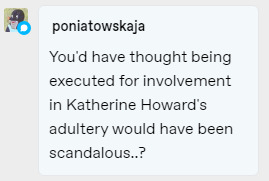
You’d think being a fucking Boleyn for over a decade would be enough to get you put in a documentary with the Boleyns but we’re pulling an Anne of a Thousand Days on this and just pretending she doesn’t exist.
Lauren Mackay was negative towards Jane in her biography of George and Thomas (though in her book on Eustace Chapuys and his time in Henry’s court I recall her being a good deal more nuanced and even defensive) so maybe she doesn’t think Jane is redeemable enough to get in on the Boleyn reexamination?
Whatever I prefer Jane Boleyn not appearing at all then having to hear a documentary claim she had any hand in her family’s downfall.
#the boleyns: a scandalous family#Jane Parker#Jane Boleyn#I know Claire Ridgeway had a hand in the script for this#so maybe she'll get some kind of mention later?#idk just let this woman have peace
6 notes
·
View notes